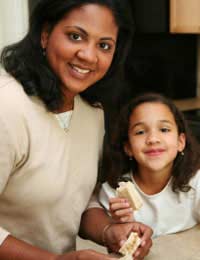Kitchen Safety for Kids

Cooking is fun! But it’s also potentially hazardous!
How can you help your kids get the most benefit and pleasure from cooking without either scaring them to death or putting them off cooking for life?
You could sit them in chairs and let them watch you. Maybe you could even let them stir the mixture occasionally! But that’s not going to encourage them to be enthusiastic cooks.
A better alternative is to make teaching the rules of safety part of learning to cook.
Making the Kitchen Safe
The kitchen is about the most dangerous place in your house so it’s good to be aware of the hazards and to try to minimise them. If your children, with children’s typical unpredictability, are going to be working in there, you’ll want to start off by making the kitchen as safe as possible before you even think about cooking. That means:- The floor should be dry and free from spills and obstructions – to prevent slipping or tripping.
- Chemicals, e.g. bleach, disinfectant, must be kept in a safe, preferably locked, cupboard.
- You should keep a fire blanket in the kitchen.
- Small appliances should be kept away from water and checked regularly for damaged cords, dodgy connections, anything that makes them look unsafe. If they spark or smell peculiar when you try to use them, don’t - until they’ve been checked.
Sharp Things
Knives are the most obvious sharp things and good habits in handling need to be encouraged:- Always pick up a knife by the handle not the blade.
- Leave knives on their sides, not edge up.
- Keep the handle dry; wipe it or it could be slippery.
- Don’t try and catch a falling knife.
- When cutting, always cut away from you, preferably onto a chopping board (of the right colour! See 'Teaching Kids Food Hygiene').
- Don’t leave knives in a bowl of soapy water; anyone reaching in unaware could cut themselves.
- Wash, dry and store carefully.
Hot Things
Very high temperatures are needed for cooking, either in the oven or on the hob. Showing your children what heat does to a piece of steak, for example, the changes it brings to the flesh, is a good way of demonstrating the danger of the extreme temperature in an entertaining and informative way.- On the hob, make sure you always keep pan handles to the side or back of the hob to avoid burning or scalding.
- Use good-quality oven gloves for handling hot dishes and always use them.
- You’ll need the oven gloves for the microwave too if you don’t use the special microwave dishes.
- When taking lids off saucepans or hot dishes, stand back as the burst of steam released can burn. It’s a good idea to encourage the use of an oven mitt then too.
- Fat is very flammable and can catch fire easily.
- As if that’s not enough, water is fat’s enemy! A splash of water into boiling fat will cause the fat to spatter everywhere so don’t keep water anywhere near the hob.
- There can be similar results when putting food into hot fat especially if the food is wet so drop or place it in carefully.
- Make sure your children know that there should be an adult with them if they’re using fat or oil for frying.
- If you have a fire blanket in the kitchen, explain to the children what it’s for and how to use it – but only in an emergency!
Small Appliances
We’ve already mentioned checking electrical appliances for damage, but here are some sensible handling precautions for the children as well. You’ll know all of this but, if you’re like most of us, you might sometimes take a chance if you’re in a hurry.- Switch off the appliance before unplugging.
- Unplug by pulling out the plug, not by pulling on the lead.
- Don’t touch electrical appliances or plugs with wet hands – that would be shocking!
- Don’t put fingers – little or big – inside!
- Don’t try and get toast out of the toaster using a fork or knife.
Anything Else?
- Yes, wipe up spills as they occur to avoid accidents.
- Unless you’re very confident they can manage, don’t leave children to cook alone, especially not on the hob
- Enjoy the fun of cooking with your children knowing that you’ve made the experience as safe as you can, and that you’re teaching them valuable life skills.
You might also like...
All the information is very useful because I love cooking. Thank you so much. It would be so useful for my brother.
beth - 27-May-12 @ 7:31 PM








